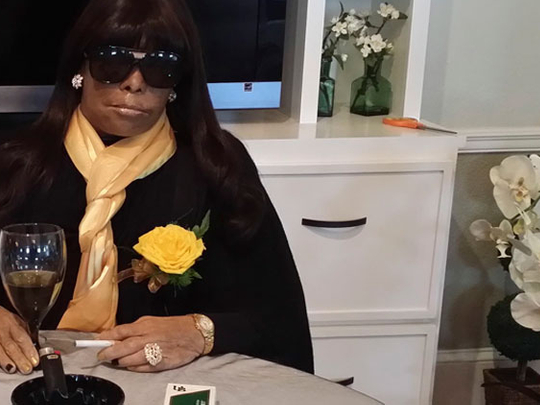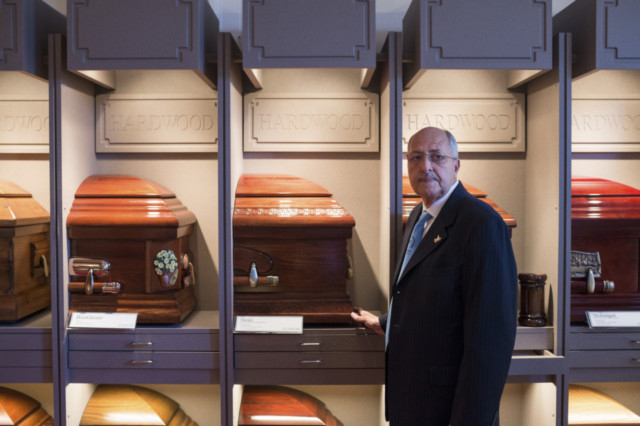
New Orleans: All last week, people were calling Louis Charbonnet to find out how they might avoid lying down at their funeral. Funeral directors have called; so have people with their own requests, such as the woman who wanted to be seen for the last time standing over her cooking pot.
The calls started coming in to the Charbonnet-Labat Funeral Home during its June 12 viewing for Miriam Burbank, who died at 53 and spent her service sitting at a table amid miniature New Orleans Saints helmets, with a can of Busch beer in one hand and a menthol cigarette between her fingers, just as she had spent a good number of her living days.
Word of the arrangement began to spread, hundreds showed up, the news spread online, and now here was Charbonnet getting a call from a funeral director in Australia.
Burbank’s service was the second of its kind that Charbonnet had arranged, and the third in New Orleans in two years. But there have been others elsewhere, most notably in San Juan, Puerto Rico. Viewings there in recent years have included a paramedic displayed behind the wheel of his ambulance and, in 2011, a man dressed for his wake like Che Guevara, cigar in hand and seated Indian style.
“I never said it was the first,” said Charbonnet, who mentioned the 1984 funeral of Willie Stokes Jr., a Chicago gambler known as the Wimp, who sat through his funeral services behind the wheel of a coffin made to look like a Cadillac Seville.
New Orleans, which has long boasted of its ability to put the “fun” in funeral, seems like the place where this kind of thing would catch on, and Charbonnet boasts that his 132-year-old funeral home is well known for its funeral parades.
“Couple weeks ago we even had a mariachi band in here,” he said, while checking text messages from people he referred to almost gleefully as his “haters” — apparently other funeral directors. They were criticising such viewings as improper or even sacrilegious, a concern Charbonnet admitted was shared by his wife. But he said that he had gotten the OK from a local priest and that, besides, he was honouring family wishes.
The phenomenon first appeared in Puerto Rico in 2008, four years before the first such funeral in New Orleans, with a 24-year-old murder victim whose viewing took place in his family’s living room, the body tethered against a wall. Angel Luis Pantojas’ funeral — called “muerto parao,” dead man standing — became an instant sensation.
Another murder victim on a motorcycle followed, along with the paramedic and the man dressed like Guevara. This year, a boxer’s body was arranged standing in a ring, and an elderly woman was propped up in her rocking chair.
The same funeral director, of the Marin Funeral Home in San Juan, arranged all of these.
“It’s been a real boom in Puerto Rico,” said Elsie Rodriguez, vice president of the funeral home. “People have requested every type of funeral that could possibly come to mind. We have only done six so far, because the people who have requested the funerals have not died yet.”
Rodriguez said the idea had come from Pantojas himself. His family has said that ever since he attended his father’s funeral at age 6, Pantojas had told relatives that he wanted to be viewed on his feet.
“This is not a fun or funny event; the family is going through a lot of pain,” Rodriguez said. With these kinds of arrangements, “the family literally suffers less, because they see their loved one in a way that would have made them happy — they see them in a way in which they still look alive.”
At first, some in Puerto Rico were against the services — which start around $1,700 (Dh6,244) — an opposition that Rodriguez attributed to “professional jealousy.” The Puerto Rico Legislature held hearings in which the Department of Health and other funeral directors weighed in.
“I thought it would propagate competitions for the most exotic funeral,” said Jorge Lugo, president of the Puerto Rico Funeral Home Association. “These people — not all of them, but some of these people who had these funerals — belonged to the underworld and had a life of fast money. It seemed to me that with these kinds of people doing this, there could be negative consequences.”
As it happened, Lugo said, the only other time a funeral home tried something unusual — the wake of a dog — it was a fiasco, as the dog had not been embalmed. A law passed in 2012 officially made the wakes with posed cadavers legal, “as long as the position is not immoral,” Lugo said.
Such funerals are still quite rare in the United States, though not unheard-of: This year, a deceased biker in Mechanicsburg, Ohio, was towed to a cemetery in a homemade Plexiglas coffin, his body astride his Harley-Davidson motorcycle. There, in accordance with his long-standing request, he was buried, motorcycle and all.
The services began in New Orleans in 2012 with the death of Lionel Batiste, a brass band leader and dapper man about town. Batiste had said he did not want to have people looking down at him at his funeral, so at his service, here at Charbonnet’s funeral home, Batiste stood with his hands on his walking cane, derby tipped rakishly to one side.
Then in April of this year, there was the service for Mickey Easterling, a socialite and proficient party hostess.
“What my mother said to me some years ago was, ‘I want to be at my own funeral having a glass of Champagne in one hand and a cigarette in the other,’” said Easterling’s daughter, Nanci. And so she was, greeting her funeral guests from an elegant bench in the lobby of a historic downtown theatre.
This month, Zymora Kimball came to the Charbonnet funeral home to ask about arrangements for Burbank, who had raised Kimball like a daughter. Burbank had been neither wealthy nor widely known outside the neighbourhood over which she presided from a table on her front porch.
Kimball wanted something “out of the box,” said Lyelle Bellard, the intern funeral director, and when he suggested his plan, she thought it brilliantly captured Burbank’s style. Bellard said it did not end up costing much more than a typical funeral.
Despite the recent interest, organisations representing funeral home directors say this kind of viewing is still rare, and just about everyone, including Kimball, acknowledges that it is not for everyone.
Even Rodriguez in San Juan said she has had to refuse a few suggestions that she found distasteful or that “made no sense.” She will not, for example, do a wake with someone in a swimsuit, she said.













